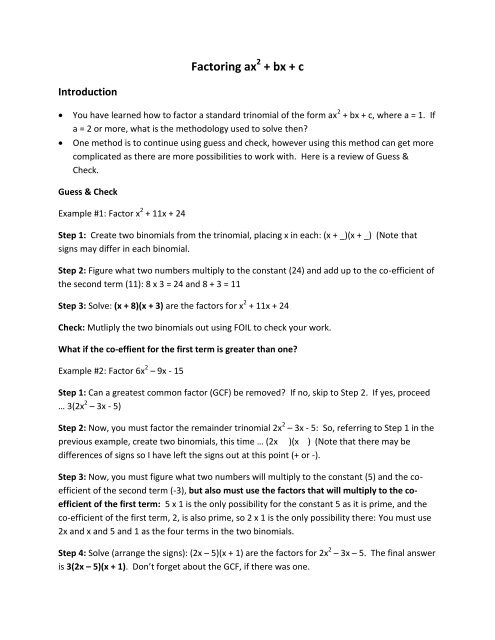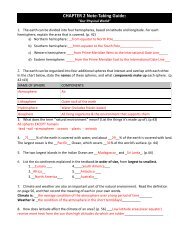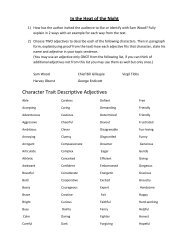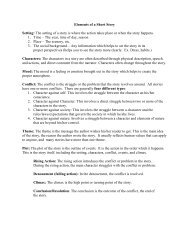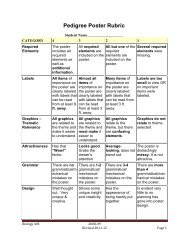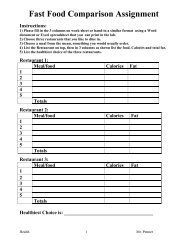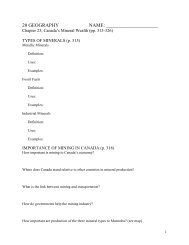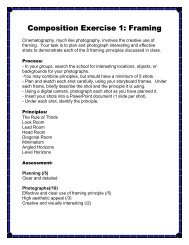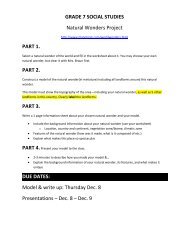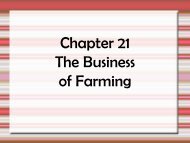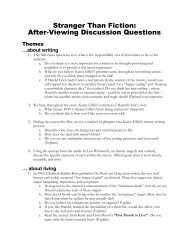Create successful ePaper yourself
Turn your PDF publications into a flip-book with our unique Google optimized e-Paper software.
Introduction<br />
<strong>Factoring</strong> <strong>ax</strong> 2 + <strong>bx</strong> + c<br />
You have learned how to factor a standard trinomial of the form <strong>ax</strong> 2 + <strong>bx</strong> + c, where a = 1. If<br />
a = 2 or more, what is the methodology used to solve then?<br />
One method is to continue using guess and check, however using this method can get more<br />
complicated as there are more possibilities to work with. Here is a review of Guess &<br />
Check.<br />
Guess & Check<br />
Example #1: Factor x 2 + 11x + 24<br />
Step 1: Create two binomials from the trinomial, placing x in each: (x + _)(x + _) (Note that<br />
signs may differ in each binomial.<br />
Step 2: Figure what two numbers multiply to the constant (24) and add up to the co-efficient of<br />
the second term (11): 8 x 3 = 24 and 8 + 3 = 11<br />
Step 3: Solve: (x + 8)(x + 3) are the factors for x 2 + 11x + 24<br />
Check: Mutliply the two binomials out using FOIL to check your work.<br />
What if the co-effient for the first term is greater than one?<br />
Example #2: Factor 6x 2 – 9x - 15<br />
Step 1: Can a greatest common factor (GCF) be removed? If no, skip to Step 2. If yes, proceed<br />
… 3(2x 2 – 3x - 5)<br />
Step 2: Now, you must factor the remainder trinomial 2x 2 – 3x - 5: So, referring to Step 1 in the<br />
previous example, create two binomials, this time … (2x )(x ) (Note that there may be<br />
differences of signs so I have left the signs out at this point (+ or -).<br />
Step 3: Now, you must figure what two numbers will multiply to the constant (5) and the coefficient<br />
of the second term (-3), but also must use the factors that will multiply to the coefficient<br />
of the first term: 5 x 1 is the only possibility for the constant 5 as it is prime, and the<br />
co-efficient of the first term, 2, is also prime, so 2 x 1 is the only possibility there: You must use<br />
2x and x and 5 and 1 as the four terms in the two binomials.<br />
Step 4: Solve (arrange the signs): (2x – 5)(x + 1) are the factors for 2x 2 – 3x – 5. The final answer<br />
is 3(2x – 5)(x + 1). Don’t forget about the GCF, if there was one.
Check: Mutliply the two binomials out (and, in this case, the GCF 3) using FOIL to check your<br />
work.<br />
What if Guess & Check really doesn’t work because there are just too many possibilities when<br />
the co-efficient has a term greater than 1? Now, we come to the Grouping Method.<br />
Grouping Method<br />
Example: Factor 8a 2 + 18a – 5<br />
Step 1: Is there a GCF? No, so skip to Step 2.<br />
Step 2: Take the co-efficient of the first term and multiply it to the constant: 8 x -5 = -40.<br />
Step 3: List all of the factors for -40: -40 x 1, -20 x 2, -10 x 4, -8 x 5 (and there opposites)<br />
Step 4: Select the two factors that will add up to the co-efficient of the second term (18) and rewrite<br />
the polynomial with those factors:<br />
a. 20 and – 2 = 18<br />
b. 8a 2 + 20a – 2a – 5<br />
Step 5: Separate the polynomial into two groups: 8a 2 + 20a and -2a – 5<br />
Step 6: Take the greatest common factor out for each group: 4a(2a + 5) – 1(2a + 5) … 4a is the<br />
GCF for the first group and -1 is the GCF for the second group.<br />
Step 7: Solve. Take the two sets of factors and re-write them. The first group is 4a – 1. The<br />
second group is the pair 2a + 5. So, the final answer uses the factors for 8a 2 + 18a – 5 as<br />
(4a – 1)(2a + 5). Note that the pair of factors in the grouping is just re-written as one binomial<br />
in the final answer.<br />
Check: If you have a pair of factors that are the same in one group (i.e. 2a + 5 in this example),<br />
you likely have the correct answer. Mutliply the two binomials out using FOIL to check your<br />
work.


